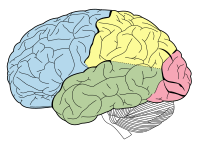
Photo from wikipedia
Through Pavlovian appetitive conditioning, environmental cues can become predictors of food availability. Over time, however, the food, and thus the value of the associated cues, can change based on environmental… Click to show full abstract
Through Pavlovian appetitive conditioning, environmental cues can become predictors of food availability. Over time, however, the food, and thus the value of the associated cues, can change based on environmental variations. This change in outcome necessitates updating of the value of the cue to appropriately alter behavioral responses to these cues. The basolateral amygdala (BLA) is critical in updating the outcomes of learned cues. However, it is unknown if the same BLA neuronal ensembles that are recruited in the initial associative memory are required when the new cue-outcome association is formed during reversal learning. The current study used the Daun02 inactivation method that enables selective targeting and disruption of activated neuronal ensembles in Fos-lacZ transgenic rats. Rats were implanted with bilateral cannulas that target the BLA and underwent appetitive discriminative conditioning in which rats had to discriminate between two auditory stimuli. One stimulus (CS+) co-terminated with food delivery, and the other stimulus was unrewarded (CS−; counterbalanced). Rats were then tested for CS+ or CS− memory retrieval and infused with either Daun02 or a vehicle solution into the BLA to inactivate either CS+ or CS− neuronal ensembles that were activated during that test. To assess if the same neuronal ensembles are necessary to update the value of the new association when the outcomes are changed, rats underwent reversal learning: the CS+ was no longer followed by food (reversal CS−, rCS−), and the CS− was now followed by food (reversal CS+; rCS+). The group that received Daun02 following CS+ session showed a decrease in conditioned responding and increased latency to the rCS− (previously CS+) during the first session of reversal learning, specifically during the first trial. This indicates that neuronal ensembles that are activated during the recall of the CS+ memory are the same neuronal ensembles needed for learning the new outcome of the same CS, now rCS−. Additionally, the group that received Daun02 following CS− session was slower to respond to the rCS+ (previously CS−) during reversal learning. This indicates that neuronal ensembles that are activated during the recall of the CS− memory are the same neuronal ensembles needed for learning the new outcome of the same CS. These results demonstrate that different neuronal ensembles within the BLA mediate memory recall of CS+ and CS− cues and reactivation of each cue-specific neuronal ensemble is necessary to update the value of that specific cue to respond appropriately during reversal learning. These results also indicate substantial plasticity within the BLA for behavioral flexibility as both groups eventually showed similar terminal levels of reversal learning. Highlights Chemogenetic inactivation of BLA neuronal ensembles activated by learned CS+ or CS− Examined if specific ensembles needed when cues’ values change in reversal learning CS+ ensemble ablation reduced responding to the same cue in early reversal learning CS− ensemble inactivation slowed learning of the new value of the cue
Journal Title: Neurobiology of Learning and Memory
Year Published: 2022
Link to full text (if available)
Share on Social Media: Sign Up to like & get
recommendations!